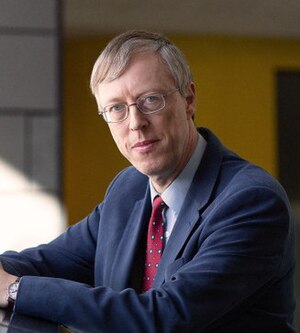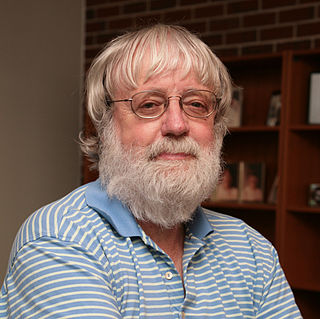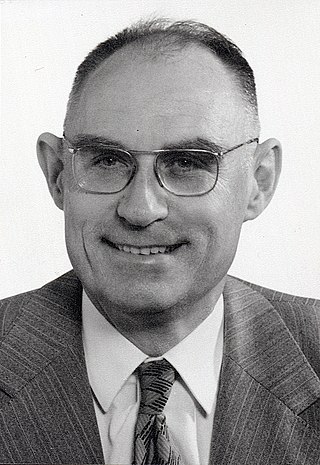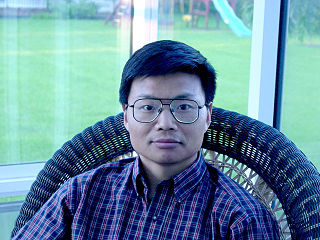
Germund Dahlquist was a Swedish mathematician known primarily for his early contributions to the theory of numerical analysis as applied to differential equations.

Nicholas John Higham FRS was a British numerical analyst. He was Royal Society Research Professor and Richardson Professor of Applied Mathematics in the Department of Mathematics at the University of Manchester.

Max D. Gunzburger, Francis Eppes Distinguished Professor of Mathematics at Florida State University, is an American mathematician and computational scientist affiliated with the Florida State interdisciplinary Department of Scientific Computing. He was the 2008 winner of the SIAM W.T. and Idalia Reid Prize in Mathematics. His seminal research contributions include flow control, finite element analysis, superconductivity and Voronoi tessellations. He has also made contributions in the areas of aerodynamics, materials, acoustics, climate change, groundwater, image processing and risk assessment.
Chi-Wang Shu is the Theodore B. Stowell University Professor of Applied Mathematics at Brown University. He is known for his research in the fields of computational fluid dynamics, numerical solutions of conservation laws and Hamilton–Jacobi type equations. Shu has been listed as an ISI Highly Cited Author in Mathematics by the ISI Web of Knowledge.
The SIAM Journal on Scientific Computing (SISC), formerly SIAM Journal on Scientific & Statistical Computing, is a scientific journal focusing on the research articles on numerical methods and techniques for scientific computation. It is published by the Society for Industrial and Applied Mathematics (SIAM). Hans De Sterck is the current editor-in-chief, assuming the role in January 2022. The impact factor is currently around 2.

Applied mathematics is the application of mathematical methods by different fields such as physics, engineering, medicine, biology, finance, business, computer science, and industry. Thus, applied mathematics is a combination of mathematical science and specialized knowledge. The term "applied mathematics" also describes the professional specialty in which mathematicians work on practical problems by formulating and studying mathematical models.

Jinchao Xu is an American-Chinese mathematician. He is currently the Verne M. Willaman Professor in the Department of Mathematics at the Pennsylvania State University, University Park. He is known for his work on multigrid methods, domain decomposition methods, finite element methods, and more recently deep neural networks.

Emmanuel Jean Candès is a French statistician most well known for his contributions to the field of Compressed sensing and Statistical hypothesis testing. He is a professor of statistics and electrical engineering at Stanford University, where he is also the Barnum-Simons Chair in Mathematics and Statistics. Candès is a 2017 MacArthur Fellow.

Peter Karl Henrici was a Swiss mathematician best known for his contributions to the field of numerical analysis.

Weinan E is a Chinese mathematician. He is known for his pathbreaking work in applied mathematics and machine learning. His academic contributions include novel mathematical and computational results in stochastic differential equations; design of efficient algorithms to compute multiscale and multiphysics problems, particularly those arising in fluid dynamics and chemistry; and pioneering work on the application of deep learning techniques to scientific computing. In addition, he has worked on multiscale modeling and the study of rare events.
Gábor Stépán, Hungarian professor of applied mechanics, member of the Hungarian Academy of Sciences, fellow of the International Academy for Production Engineering (CIRP), fellow of the Society for Industrial and Applied Mathematics (SIAM), former dean of the Faculty of Mechanical Engineering in the Budapest University of Technology and Economics. Won the Széchenyi Prize in 2011, the Thomas K. Caughey Dynamics Award in 2015, and the Delay Systems Lifetime Achievements Award in 2021. His research fields include nonlinear vibrations, delay-differential equations, and stability theory. He was elected as a fellow of the Society for Industrial and Applied Mathematics in 2017, "for contributions to the theory and analysis of delayed dynamical systems and their applications".

Alan Stuart Edelman is an American mathematician and computer scientist. He is a professor of applied mathematics at the Massachusetts Institute of Technology (MIT) and a Principal Investigator at the MIT Computer Science and Artificial Intelligence Laboratory (CSAIL) where he leads a group in applied computing. In 2004, he founded a business called Interactive Supercomputing which was later acquired by Microsoft. Edelman is a fellow of American Mathematical Society (AMS), Society for Industrial and Applied Mathematics (SIAM), Institute of Electrical and Electronics Engineers (IEEE), and Association for Computing Machinery (ACM), for his contributions in numerical linear algebra, computational science, parallel computing, and random matrix theory. He is one of the creators of the technical programming language Julia.
Marsha J. Berger is an American computer scientist. Her areas of research include numerical analysis, computational fluid dynamics, and high-performance parallel computing. She is a Silver Professor (emeritus) of Computer Science and Mathematics in the Courant Institute of Mathematical Sciences of New York University. She is Group Leader of Modeling and Simulation in the Center for Computational Mathematics at the Flatiron Institute.
Thomas Yizhao Hou is the Charles Lee Powell Professor of Applied and Computational Mathematics in the Department of Computing and Mathematical Sciences at the California Institute of Technology. He is known for his work in numerical analysis and mathematical analysis.
Tamara G. Kolda is an American applied mathematician and former Distinguished Member of Technical Staff at Sandia National Laboratories. She is noted for her contributions in computational science, multilinear algebra, data mining, graph algorithms, mathematical optimization, parallel computing, and software engineering. She is currently a member of the SIAM Board of Trustees and served as associate editor for both the SIAM Journal on Scientific Computing and the SIAM Journal on Matrix Analysis and Applications.

Robert James Plemmons is an American mathematician specializing in computational mathematics. He is the Emeritus Z. Smith Reynolds Professor of Mathematics and Computer Science at Wake Forest University. In 1979, Plemmons co-authored the book Nonnegative Matrices in the Mathematical Sciences.
Tang Tao is a Chinese mathematician currently serving as President of BNU-HKBU United International College. Tang is a member of the Chinese Academy of Sciences, Fellow of the European Academy of Sciences, Fellow of The World Academy of Sciences for the advancement of science in developing countries (TWAS). He is also a fellow of the Society for Industrial and Applied Mathematics and American Mathematical Society.
Jennifer Ann Scott is a British mathematician specialising in numerical analysis, sparse matrix computations, and parallel computing. She is a professor of applied mathematics at the University of Reading, where she directs the Centre for the Mathematics of Planet Earth, and a Group Leader and Individual Merit Research Fellow for the Science and Technology Facilities Council at the Rutherford Appleton Laboratory.
Assyr Abdulle was a Swiss mathematician. He specialized in numerical mathematics.










